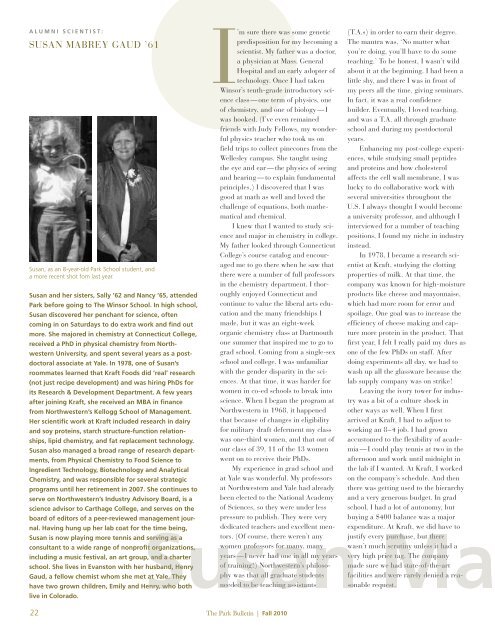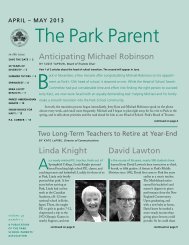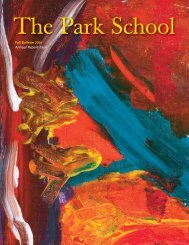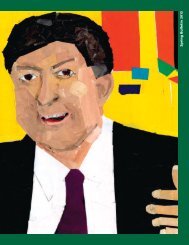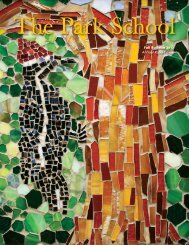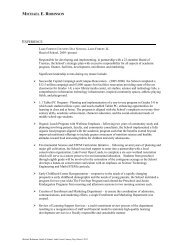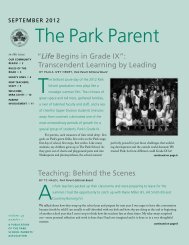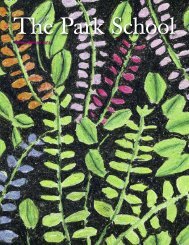⢠ParkBulletinCover - The Park School
⢠ParkBulletinCover - The Park School
⢠ParkBulletinCover - The Park School
- No tags were found...
Create successful ePaper yourself
Turn your PDF publications into a flip-book with our unique Google optimized e-Paper software.
A L U M N I S C I E N T I S T :SUSAN MABREY GAUD ’61Susan, as an 8-year-old <strong>Park</strong> <strong>School</strong> student, anda more recent shot fom last year.Susan and her sisters, Sally ’62 and Nancy ’65, attended<strong>Park</strong> before going to <strong>The</strong> Winsor <strong>School</strong>. In high school,Susan discovered her penchant for science, oftencoming in on Saturdays to do extra work and find outmore. She majored in chemistry at Connecticut College,received a PhD in physical chemistry from NorthwesternUniversity, and spent several years as a postdoctoralassociate at Yale. In 1978, one of Susan’sroommates learned that Kraft Foods did ‘real’ research(not just recipe development) and was hiring PhDs forits Research & Development Department. A few yearsafter joining Kraft, she received an MBA in financefrom Northwestern’s Kellogg <strong>School</strong> of Management.Her scientific work at Kraft included research in dairyand soy proteins, starch structure-function relationships,lipid chemistry, and fat replacement technology.Susan also managed a broad range of research departments,from Physical Chemistry to Food Science toIngredient Technology, Biotechnology and AnalyticalChemistry, and was responsible for several strategicprograms until her retirement in 2007. She continues toserve on Northwestern’s Industry Advisory Board, is ascience advisor to Carthage College, and serves on theboard of editors of a peer-reviewed management journal.Having hung up her lab coat for the time being,Susan is now playing more tennis and serving as aconsultant to a wide range of nonprofit organizations,including a music festival, an art group, and a charterschool. She lives in Evanston with her husband, HenryGaud, a fellow chemist whom she met at Yale. <strong>The</strong>yhave two grown children, Emily and Henry, who bothlive in Colorado.I’m sure there was some geneticpredisposition for my becoming ascientist. My father was a doctor,a physician at Mass. GeneralHospital and an early adopter oftechnology. Once I had takenWinsor’s tenth-grade introductory scienceclass—one term of physics, oneof chemistry, and one of biology—Iwas hooked. (I’ve even remainedfriends with Judy Fellows, my wonderfulphysics teacher who took us onfield trips to collect pinecones from theWellesley campus. She taught usingthe eye and ear—the physics of seeingand hearing—to explain fundamentalprinciples.) I discovered that I wasgood at math as well and loved thechallenge of equations, both mathematicaland chemical.I knew that I wanted to study scienceand major in chemistry in college.My father looked through ConnecticutCollege’s course catalog and encouragedme to go there when he saw thatthere were a number of full professorsin the chemistry department. I thoroughlyenjoyed Connecticut andcontinue to value the liberal arts educationand the many friendships Imade, but it was an eight-weekorganic chemistry class at Dartmouthone summer that inspired me to go tograd school. Coming from a single-sexschool and college, I was unfamiliarwith the gender disparity in the sciences.At that time, it was harder forwomen in co-ed schools to break intoscience. When I began the program atNorthwestern in 1968, it happenedthat because of changes in eligibilityfor military draft deferment my classwas one-third women, and that out ofour class of 39, 11 of the 13 womenwent on to receive their PhDs.My experience in grad school andat Yale was wonderful. My professorsat Northwestern and Yale had alreadybeen elected to the National Academyof Sciences, so they were under lesspressure to publish. <strong>The</strong>y were verydedicated teachers and excellent mentors.(Of course, there weren’t anywomen professors for many, manyyears—I never had one in all my yearsof training!) Northwestern’s philosophywas that all graduate studentsneeded to be teaching assistants(T.A.s) in order to earn their degree.<strong>The</strong> mantra was, ‘No matter whatyou’re doing, you’ll have to do someteaching.’ To be honest, I wasn’t wildabout it at the beginning. I had been alittle shy, and there I was in front ofmy peers all the time, giving seminars.In fact, it was a real confidencebuilder. Eventually, I loved teaching,and was a T.A. all through graduateschool and during my postdoctoralyears.Enhancing my post-college experiences,while studying small peptidesand proteins and how cholesterolaffects the cell wall membrane, I waslucky to do collaborative work withseveral universities throughout theU.S. I always thought I would becomea university professor, and although Iinterviewed for a number of teachingpositions, I found my niche in industryinstead.In 1978, I became a research scientistat Kraft, studying the clottingproperties of milk. At that time, thecompany was known for high-moistureproducts like cheese and mayonnaise,which had more room for error andspoilage. One goal was to increase theefficiency of cheese making and capturemore protein in the product. Thatfirst year, I felt I really paid my dues asone of the few PhDs on staff. Afterdoing experiments all day, we had towash up all the glassware because thelab supply company was on strike!Leaving the ivory tower for industrywas a bit of a culture shock inother ways as well. When I firstarrived at Kraft, I had to adjust toworking an 8–4 job. I had grownaccustomed to the flexibility of academia—Icould play tennis at two in theafternoon and work until midnight inthe lab if I wanted. At Kraft, I workedon the company’s schedule. And thenthere was getting used to the hierarchyand a very generous budget. In gradschool, I had a lot of autonomy, butbuying a $400 balance was a majorexpenditure. At Kraft, we did have tojustify every purchase, but therewasn’t much scrutiny unless it had avery high price tag. <strong>The</strong> companymade sure we had state-of-the-artfacilities and were rarely denied a reasonablerequest.22 <strong>The</strong> <strong>Park</strong> Bulletin | Fall 2010


